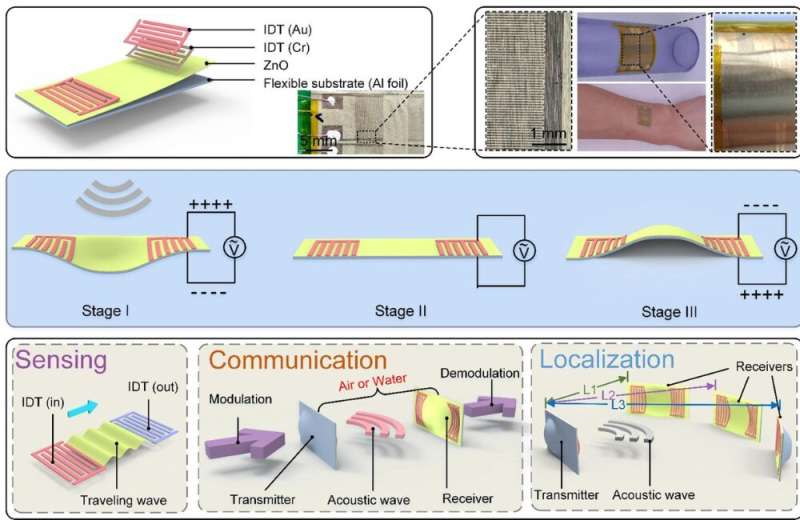A graphic showing the principles of sensing and communication, acoustic ranging (identifying the distance), and positioning (finding locations) using the flexible acoustic wave device. Credit: Northumbria University
New research involving a Northumbria University Professor has developed a wearable sensor capable of wirelessly transmitting information via acoustic waves through air and water.
With enough flexibility to be fitted into a wearable patch, Professor Richard Fu and his research partners—led by Professor Jin Xie at Zhejiang University in China—believe the flexible acoustic wave device could have multiple uses in health care and the water industry.
Interest in advancing the capabilities of flexible and wireless sensors is at an all-time high, thanks to their widespread uses in wearable electronics such as smart watches and internet of things (IoTs) or smart home devices, which are now commonplace across the world.
However, many sensors require additional antenna to achieve wireless or real-time functions, which has an impact on their size. And the performance of those operated with radio frequency signals (RF) has been shown to deteriorate when used in water and inside metal.
To find a solution, research teams led by Professor Fu and Professor Xie have worked together to identify surface materials that are flexible enough to withstand tiny vibrations capable of transmitting and receiving information, in order to develop their device as a wearable patch.
They believe the design is multifunctional and could be used, for example, to wirelessly transmit information on a patient's heart rate during hospital treatment. The sensors have also proven effective in tests through water and could have practical applications including diagnosing the location of a maintenance issue, such as a blockage, from within a metal water pipe.
A research paper recently published in the journal, Advanced Functional Materials, describes the detail of the ground-breaking work by both research teams.
Professor Fu explained, "We feel it is a real breakthrough to have used a multifunctional and flexible sound wave device, operated based on electricity resulting from pressure and heat (piezoelectricity), for achieving integrated sensing, acoustic communication and positioning functions."
Professor Xie added, "Based on this new methodology, this type of sensor could serve as an acoustic transmitter and receiver (transceiver) without any additional antenna, thus reducing the complications and size of the system. Because of the low velocity of the acoustic waves, the acoustic ranging and positioning can be directly performed, significantly improving precision when compared to those based on Bluetooth and Radio Frequency Identification (RFID)."
The research was supported by students from Zhejiang University during a visit to Northumbria University, and has received some support from the Royal Society International Exchange Project.
Professor Fu, whose key research area is in smart materials, thin film and microsystems, has been working with collaborators and researchers from Zhejiang for a number of years. Their research has also produced papers published in scientific journals including Nano Energy, ACS Applied Materials & Interfaces, ACS Sensors, Microsystems & Nanoengineering and Applied Physics Letters.
Dr. Richard Binns, Head of Department for Mathematics, Physics, and Electrical Engineering at Northumbria University said, "Collaboration is an important part of the research culture at Northumbria. We work closely with hundreds of partner universities, colleges and schools across the world.
"It's wonderful to see the strong partnership between Northumbria University and Zhejiang University producing quality research outputs, as well as the benefits of staff and students from both universities working together."
More information: Qian Zhang et al, Multifunctional and Wearable Patches Based on Flexible Piezoelectric Acoustics for Integrated Sensing, Localization, and Underwater Communication, Advanced Functional Materials (2022). DOI: 10.1002/adfm.202209667
Journal information: Advanced Functional Materials , Applied Physics Letters
Provided by Northumbria University
























